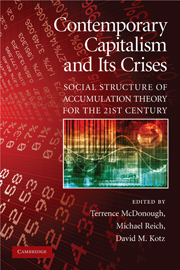Book contents
- Frontmatter
- Contents
- List of Tables
- List of Figures
- List of Contributors
- Acknowledgments
- Introduction: Social Structure of Accumulation Theory for the 21st Century
- PART I THE THEORY OF SOCIAL STRUCTURES OF ACCUMULATION
- PART II GLOBALIZATION AND THE CONTEMPORARY SOCIAL STRUCTURE OF ACCUMULATION
- PART III THE CONTEMPORARY SOCIAL STRUCTURE OF ACCUMULATION IN THE UNITED STATES
- 8 Labor in the Contemporary Social Structure of Accumulation
- 9 The Rise of CEO Pay and the Contemporary Social Structure of Accumulation in the United States
- 10 Social Structures of Accumulation and the Criminal Justice System
- PART IV SOCIAL STRUCTURE OF ACCUMULATION THEORY AND TRANSFORMATIONS OF THE CAPITALIST PERIPHERY
- Index
- References
9 - The Rise of CEO Pay and the Contemporary Social Structure of Accumulation in the United States
Published online by Cambridge University Press: 05 June 2012
- Frontmatter
- Contents
- List of Tables
- List of Figures
- List of Contributors
- Acknowledgments
- Introduction: Social Structure of Accumulation Theory for the 21st Century
- PART I THE THEORY OF SOCIAL STRUCTURES OF ACCUMULATION
- PART II GLOBALIZATION AND THE CONTEMPORARY SOCIAL STRUCTURE OF ACCUMULATION
- PART III THE CONTEMPORARY SOCIAL STRUCTURE OF ACCUMULATION IN THE UNITED STATES
- 8 Labor in the Contemporary Social Structure of Accumulation
- 9 The Rise of CEO Pay and the Contemporary Social Structure of Accumulation in the United States
- 10 Social Structures of Accumulation and the Criminal Justice System
- PART IV SOCIAL STRUCTURE OF ACCUMULATION THEORY AND TRANSFORMATIONS OF THE CAPITALIST PERIPHERY
- Index
- References
Summary
Introduction
Social structure of accumulation (SSA) theory has contributed to our understanding of contemporary capitalist economies by pointing out the basic social relations and economic mechanisms that were at the origin of the post-World War II golden age (Bowles, Gordon, and Weisskopf 1983) and then detecting the emerging crisis of this regime: the previous mechanisms were unable to overcome the nonreproductive cycle during the 1970s. The first wave of this research showed the key role of the transformation of work and capital/labor relations in the emergence of the post-World War II SSA (Gordon, Edwards, and Reich 1982). A second wave investigated the impact of conservative strategies upon the overcoming of this structural crisis and the absence of a clear alternative to the previous SSA regime (Gordon, Weisskopf, and Bowles 1989). This is a clear contribution to a political economy of contemporary capitalism (Kotz, McDonough, and Reich 1994).
Regulation theory has followed a parallel strategy. First, it coined the concept of a Fordist accumulation regime as an explanation of the high and stable growth observed not only in the United States but in France as well after World War II (Aglietta 1982; Boyer, and Saillard 2002). Second, it argued that this regime, built upon an unprecedented capital/labor compromise, entered a structural crisis in the early 1970s (Boyer and Juillard 2002) and since then, collective actors have struggled in order to redefine the basic institutional forms according to their interests.
- Type
- Chapter
- Information
- Contemporary Capitalism and its CrisesSocial Structure of Accumulation Theory for the 21st Century, pp. 215 - 238Publisher: Cambridge University PressPrint publication year: 2010
References
- 8
- Cited by

